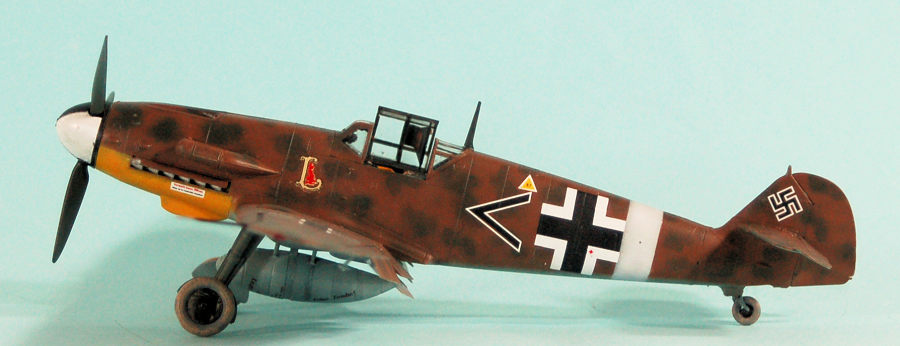
| KIT #: | 82117 |
| PRICE: | $49.95 SRP |
| DECALS: | Five options |
| REVIEWER: | Tom Cleaver |
| NOTES: | Profipack version |

| HISTORY |
The Bf 109 G-series was developed from the nearly-identical F-series airframe. Modifications included a reinforced wing structure, an internal bullet-proof windscreen, the use of heavier, welded framing for the cockpit canopy, and additional armor for the fuel tank. Since originally it was intended that the wheel wells would incorporate small doors to cover the outer portion of the wheels when retracted, the outer wheel bays were squared off. Two small inlet scoops for additional cooling of the spark plugs were added on both sides of the forward engine cowlings.
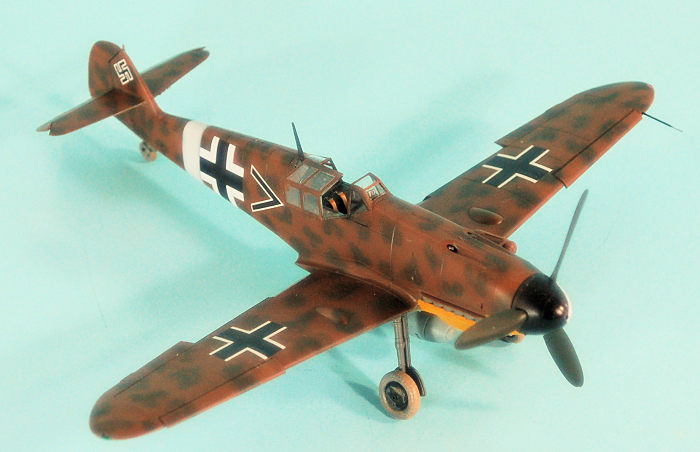 The
Daimler-Benz DB 605A engine was a development of the DB 601E engine that powered
the Bf-109F-4. The displacement and compression ratio were increased as well as
other detail improvements to ease large-scale mass production. Takeoff and
emergency power of 1,455 hp was achieved with 42.5 inches of manifold pressure
at 2,800 rpm. The DB 605 suffered from reliability problems during the first
year of operation, and Luftwaffe units were ordered to limit maximum power
output to 1,292 hp at 2,600 rpm and 38.9 inches of manifold pressure.
Daimler-Benz eventually The full output was not reinstated until June 1943.
Writing in his memoir, “I Flew For The Fuhrer,” JG 11 pilot Heinz Knoke stated
that the Bf-109G had to be flown in the landing pattern at full power with gear
and flaps down.
The
Daimler-Benz DB 605A engine was a development of the DB 601E engine that powered
the Bf-109F-4. The displacement and compression ratio were increased as well as
other detail improvements to ease large-scale mass production. Takeoff and
emergency power of 1,455 hp was achieved with 42.5 inches of manifold pressure
at 2,800 rpm. The DB 605 suffered from reliability problems during the first
year of operation, and Luftwaffe units were ordered to limit maximum power
output to 1,292 hp at 2,600 rpm and 38.9 inches of manifold pressure.
Daimler-Benz eventually The full output was not reinstated until June 1943.
Writing in his memoir, “I Flew For The Fuhrer,” JG 11 pilot Heinz Knoke stated
that the Bf-109G had to be flown in the landing pattern at full power with gear
and flaps down.
The Bf-109G-4 appeared in September 1942. It was generally similar externally to the Bf-109G-2, but was fitted with the FuG 16 VHF radio set, which provided much clearer radio transmissions and had three-times the range of the earlier HF sets. Due to the steady weight increases of the Bf-109, larger 660 × 160 mm main wheels were introduced, replacing the previously used 650 × 150 mm type. The undercarriage legs were altered so that the vertical axis of the wheel was nearly upright rather than being parallel with the oleo leg, which improved controllability on takeoff. These changes saw a teardrop-shaped fairing fitted to the upper wing surface above the wheel-wells to accommodate the upper part of the wheels. Additionally, a larger 350 × 135 mm tailwheel replaced the original 290 × 110 mm wheel. Since the larger tailwheel no longer fitted the recess, the retraction mechanism was disconnected and the tailwheel was fixed down. 1,242 G-4s were produced between September 1942-July 1943.
JG 77 in North Africa:
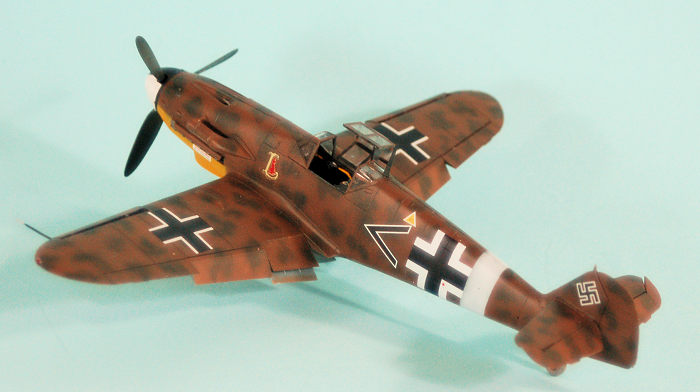 From the
entry of the Afrika Korps into combat in North Africa in May 1941 until August
1942, the only assigned fighter unit was JG 27. III/JG 53 moved to North Africa
to reinforce the Afrika Geschwader at the end of July. In mid-October, in the
face of increased RAF air opposition leading up to the Battle of El Alamein,
I/JG 27 and I/JG 77 moved from Sicily where they had been engaged in the final
campaign against Malta, while II/JG 53 and the Jabos of I/Sch.G 2 also flew in
for reinforcement. In late October, a decision was made that war-weary JG 27
would be entirely replaced by JG 77, which was still operating II and III
Gruppen on the southern Eastern Front under the leadership of famed experte
Joahim Muncheberg. III/JG 77 duly arrived in North Africa on October 29,
followed by II/JG 77 in early December. JG 27 departed North Africa for Italy in
late November.
From the
entry of the Afrika Korps into combat in North Africa in May 1941 until August
1942, the only assigned fighter unit was JG 27. III/JG 53 moved to North Africa
to reinforce the Afrika Geschwader at the end of July. In mid-October, in the
face of increased RAF air opposition leading up to the Battle of El Alamein,
I/JG 27 and I/JG 77 moved from Sicily where they had been engaged in the final
campaign against Malta, while II/JG 53 and the Jabos of I/Sch.G 2 also flew in
for reinforcement. In late October, a decision was made that war-weary JG 27
would be entirely replaced by JG 77, which was still operating II and III
Gruppen on the southern Eastern Front under the leadership of famed experte
Joahim Muncheberg. III/JG 77 duly arrived in North Africa on October 29,
followed by II/JG 77 in early December. JG 27 departed North Africa for Italy in
late November.
The Allied landings in French North Africa forced the Germans to face a new enemy and fight on two fronts. I and III/JG 53 crossed from Sicily to Tunisia the week after the Operation Torch landings. In January II/JG 51 arrived, followed by II.JG 2 which introduced the FW-190 to the theater.
Initially, the German pilots found the USAAF pilots overconfident and inexperienced. P-38 pilots were willing to try and dogfight the more maneuverable German fighters and their losses were such that the remaining two P-38 groups in the Eighth Air Force were sent as reinforcements, with the entire 82nd Fighter Group arriving in December; in January, the 78th FG was stripped of all pilots other than flight and squadron leaders and all P-38s, which were sent to North Africa to make up losses. Eventually, the overwhelming numerical superiority of the USAAF overcame German quality, as the Germans were unable to make up losses as the Americans could.
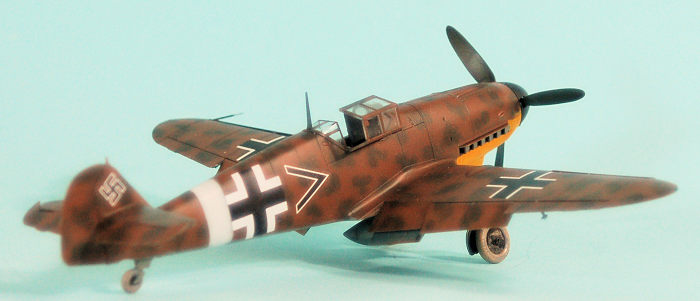 Joachim
Muncheberg was killed in combat on March 23, 1943 when he collided with the
Spitfire Vb of the 31st FG that would have been his 135th victory. He was
replaced by Johannes “Macki” Steinhoff, a 150-victory experte who had commanded
II/JG 52 in Russia. By May, the much-reduced three Gruppen of JG 77 were
operating from the Cape Bon peninsula and could only offer slight resistance to
the overwhelming USAAF and RAF units that opposed them. On May 7, 1943, Tunis
and Bizerte fell and the last of the Jagdflieger fled to Sicily.
Joachim
Muncheberg was killed in combat on March 23, 1943 when he collided with the
Spitfire Vb of the 31st FG that would have been his 135th victory. He was
replaced by Johannes “Macki” Steinhoff, a 150-victory experte who had commanded
II/JG 52 in Russia. By May, the much-reduced three Gruppen of JG 77 were
operating from the Cape Bon peninsula and could only offer slight resistance to
the overwhelming USAAF and RAF units that opposed them. On May 7, 1943, Tunis
and Bizerte fell and the last of the Jagdflieger fled to Sicily.
Leutnant Heinz-Edgar Berres:
Heinz-Edgar Berres was posted to 3.(J)./Lehrgeschwader 2 in the summer of 1941. The unit joined Operation Barbarossa in August and on November 29, 1941, he scored his first victory when he shot down a Tupolev SB-2. On 29 December 1941, he claimed his second victory, a Polikarpov I-15. On February 28, 1942 he claimed another I-15 and a Polikarpov R-5 on March 9, 1942. On March 24 he claimed an I-16.
Berres Staffel became 3 staffel of 1/JG 77 when I(J)./Lehrgeschwader 2 was transferred on January 6, 1942. Berres adopted the insignia of I(J)/Lehrgeschwader 2 as his personal insignia on his airplanes. I/JG 77 was transferred to Romania in late March and on June 12, 1942, 13 B-24D Liberators of the "Halverson project" (HALPRO) attacked Ploesti. Berres' staffel was scrambled to intercept and he claimed one B-24D shot down.
At the end of June, I/JG 77 was transferred to Sicily for operations over Malta and Berres scored his eighth victory, a Spitfire of 603 Squadron. By the end of October, when the Luftwaffe campaign against Malta concluded, Berres had been victorious over 11 Spitfires. He was made Gruppe Adjutant at the conclusion of the campaign in recognition of his success.
I/JG 77 transferred to North Africa at the end of October. On November I, Berres claimed a Curtiss P-40 Kittyhawk over Bir-el-Abd, and other on November 3 northwest of Quotaifiya, and another over Marble Arch on November 11.On December 7, he shot down Martin Baltimore from 60 Squadron SAAF west of El Haseiat. Berres' 25th and last victory of 1942 was a Spitfire over El Agheila on December 14. The claim was his 25th aerial victory.
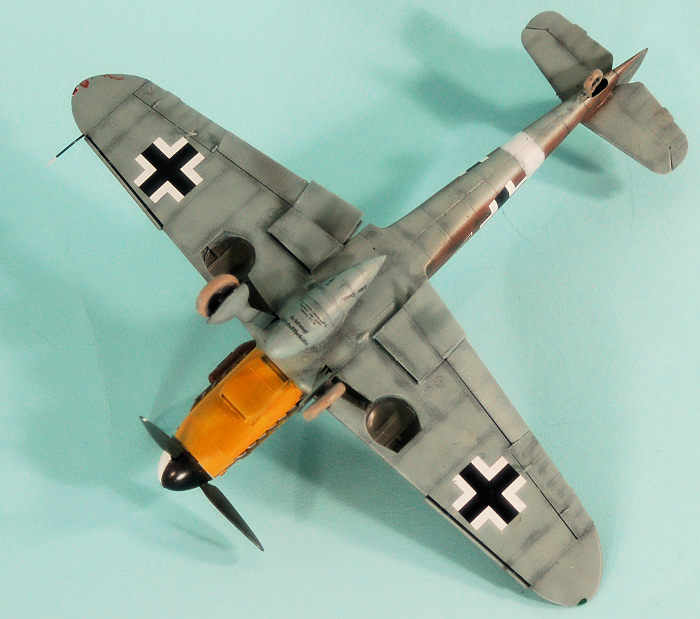 In
January 1943, I/JG 77 moved into southern Tunisia to confront the Americans. He
claimed a US-flown Spitfire on January 8 and a B-25 Mitchell on January 14. He
claimed two P-38s on February 4, 1943 Berres claimed two Lockheed P-38 Lightning
fighters and a B-25 four days later, ending the month with two P-40s on February
26. The Battle of the Mareth Line began in March and on March 7, engaged
Spitfires over the frontline and claimed one shot down for his 33rd victory.
In
January 1943, I/JG 77 moved into southern Tunisia to confront the Americans. He
claimed a US-flown Spitfire on January 8 and a B-25 Mitchell on January 14. He
claimed two P-38s on February 4, 1943 Berres claimed two Lockheed P-38 Lightning
fighters and a B-25 four days later, ending the month with two P-40s on February
26. The Battle of the Mareth Line began in March and on March 7, engaged
Spitfires over the frontline and claimed one shot down for his 33rd victory.
In March, Berres was placed in command of 1st Staffel. On March 10, he was one of the JG-77 pilots escorting 15 Ju 87s from StG 3. Intercepted by RAF Spitfires, the Stuka leader, Leutnant Heinz Üldemann was shot down and killed, but JG 77 claimed nine Spitfires destroyed, one of which was Berres’ 34th victory in the air battle. On March 24, the day after the loss of Joachim Müncheberg, Berres led 13 Bf 109s of I./JG 77 that intercepted 18 B-25 Mitchells of the 321st Bombardment Group, escorted by P-40s of the 57th and 58th Fighter Groups. Berres claimed a P-40, a B-25, and another P-40 in 11 minutes for his 37th, 38th and 39th victories. After claiming his 40th victory over a P-40 on April 2, Berres was shot down near Oudref but escaped back to German lines. He claimed his 44th victory over Cap Bon on May 5 before I/JG 77 escaped to Sicily.
Heinz-Edgar Berres was killed in combat with RAF Spitfires led by Wing Commander Colin Gray on July 25, 1943, when JG 77s 12 Bf-109s escorting 10 Ju-52s to Sicily were intercepted over the Straits of Messina. Four Bf-109s were shot down, with three of the pilots surviving. Berres Bf-109G-6 caught fire and exploded when it hit the water. He was posthumously promoted to Hauptmann and awarded the Knight’s Cross of the Iron Cross in recognition of his 52 victories.
| THE KIT |
Eduard’s Bf-109G-4 Profipack was released last spring, a month after release of the Bf-109G-2 kit. As with all the other new-design 109s, it is a definitive kit of the sub-type. The kit has Cartograf decals for five aircraft, including Erich Hartman’s first Bf-109G.
| CONSTRUCTION |
The only thing I found I needed to be concerned with was insuring I used the correct wheel well liners, since the kit provides both that for the earlier sub-types and the correct one for the G-4 and G-6.
| COLORS & MARKINGS |
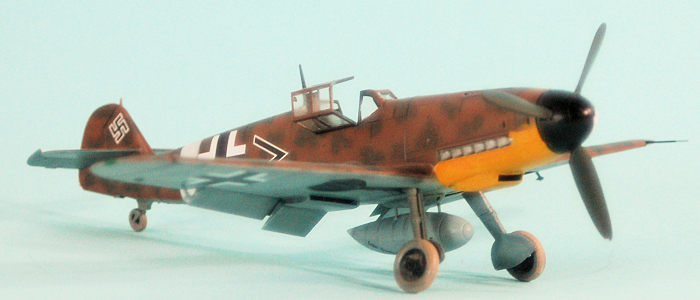 In
January 1943, Berres began flying a newly-delivered Bf-109G-4, which had been
freshly painted in RLM 79 Tan, with RLM 80 blotches. I used Xtracrylix paints
for this and freehanded the scheme.
In
January 1943, Berres began flying a newly-delivered Bf-109G-4, which had been
freshly painted in RLM 79 Tan, with RLM 80 blotches. I used Xtracrylix paints
for this and freehanded the scheme.
There are no decals for his airplane, but I was able to piece together the markings from various sheets. Fortunately, I never throw away decals and was thus able to use the I(J)/Lehrgeschwader 2 insignia from the old Fujimi kit (which has all the squadron and group insignias for units that flew the 109) to get his personal marking.
| CONCLUSIONS |
It’s an Eduard 109 kit - to my mind these are the best on the market. They don’t try to be toys, like the products of another well-known manufacturer I won’t name here. If you take care in assembly, you’ll always have a great model, and with 109s, there are a bazillion different schemes to do one in.
7 May 2020
Copyright ModelingMadness.com.
If you would like your product reviewed fairly and fairly quickly, please
contact the editor or see other details in the
Note to
Contributors.
Back to the Main Page
Back to the Review Index Page
Back to the Previews Index Page